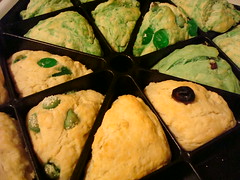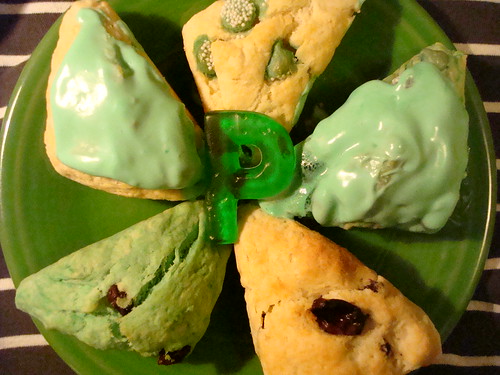
Without a doubt, one of the best thing about holidays is the seasonal sweets that come with them: pumpkin pie at Thanksgiving, chocolates for Valentine's Day, Cookies of all sorts for Christmas. And yet, for us, St. Patrick's Day has always remained a seasonal void for baked goods--though we've spied some great ideas which we hope will become the new traditions (like this or this), it still seems like the staple is Irish Soda Bread.
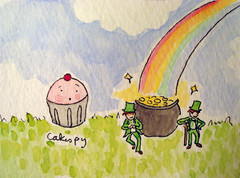 But why the bad blood toward the humble bread? Thinking that perhaps understanding would garner appreciation, we researched its history a bit. What we learned was a bit of surprise--not an ancient bread by any means, Irish Soda bread only dates back to the 1840's or so, when Bicarbonate of soda (the bread's yeast-alternative leavening agent) was first introduced to the country, and gained popularity not because of its deliciousness per se, but because it was quick, easy and cheap to make. Traditionally it was not a sweet bread, instead made in a griddle with the most basic of ingredients--flour, buttermilk, salt and baking soda (no sugar!). The resulting bread was dense and highly perishable, with a bit of a sour tang (read more about it here!). It is thought that the ingredients which became popular later on--sugar, raisins, carraway seeds--were added to enhance flavor and shelf life. (Also, for some trivia, it appears that while some say the typical slash atop Soda bread rounds is a cross, to ward off the devil; others say the reason for this is much more practical--simply a scoring to make it easier to divide into fourths after baking).
But why the bad blood toward the humble bread? Thinking that perhaps understanding would garner appreciation, we researched its history a bit. What we learned was a bit of surprise--not an ancient bread by any means, Irish Soda bread only dates back to the 1840's or so, when Bicarbonate of soda (the bread's yeast-alternative leavening agent) was first introduced to the country, and gained popularity not because of its deliciousness per se, but because it was quick, easy and cheap to make. Traditionally it was not a sweet bread, instead made in a griddle with the most basic of ingredients--flour, buttermilk, salt and baking soda (no sugar!). The resulting bread was dense and highly perishable, with a bit of a sour tang (read more about it here!). It is thought that the ingredients which became popular later on--sugar, raisins, carraway seeds--were added to enhance flavor and shelf life. (Also, for some trivia, it appears that while some say the typical slash atop Soda bread rounds is a cross, to ward off the devil; others say the reason for this is much more practical--simply a scoring to make it easier to divide into fourths after baking).
But moreover, it seems to us that while Irish Soda Bread is a tradition, it seems that deliciousness was never at its core. After all, additions had been made to improve the flavor over time...so why not take it a few steps further? We resolved to channel our Irish Heritage and get baking. We found a goodlookin' recipe here (sans raisins, but as you'll see below this was not a problem for us), and put together the ingredients and tried out several variations, segregating each trial in a different panel in our favorite scone pan. Here's what we tried and how it all tasted:
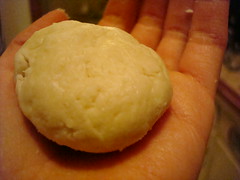
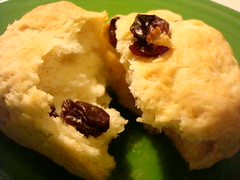
As a control, we tried at least one variation true to the original recipe; the resulting taste was, as expected, slightly sweet with a slight tang, tasty when just out of the oven, but largely un-exceptional after (Cakespy Note: by saying this we do not mean to talk smack about the recipe itself, but Soda Bread in general).
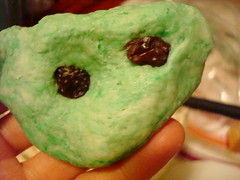
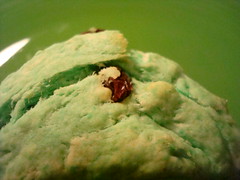
Our first variation was a test to see if perhaps the bread might be livened up by adding some green dye; however, while we swear some foods will taste better if they're a certain color, it was not true in the case of Irish Soda Bread. However, we would be remiss if we didn't remark on the fact that the green bread was far cuter than its classic counterpart.
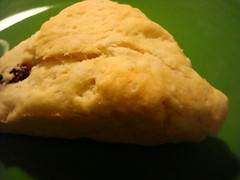
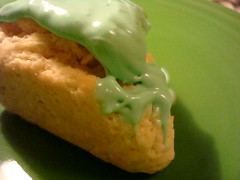
Next, we tried to add a little sweetness to the mix, by soaking the raisins in sugar water before baking. We'd heard that soaking dried fruit in such a manner can plump it, discouraging dehydration during baking, and indeed, while no different in appearance than the classic recipe, the slightly sweet and far more moist raisins did add a little something. However, to really seal in the flavor, we realized that adding some frosting (green, naturally) might help. It did.
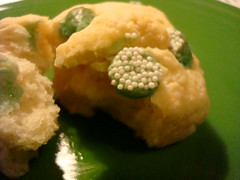
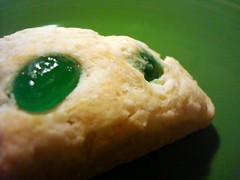
While also on that sweet path, we sampled some variations on the raisins--one with our beloved melty mints and one with jellybeans--green, naturally. In both cases, the moister texture and added bit of sweetness thanks to the additions was welcome, chasing away the acidity of the salt and baking soda. And, you know, they had a higher quotient of adorableness than the classic bread.
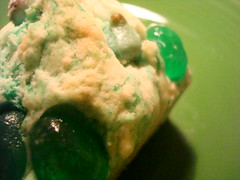
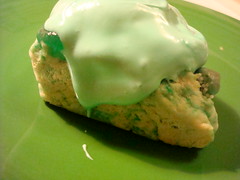
At this point, we felt like we had something--but it still wasn't completely realized yet. So for our final attempt, we combined all the best aspects of the above experiments into one mighty, some might say extreme Irish soda bread--green food coloring, melty mints, green jelly bellies, and of course green frosting. The result? Well, let's just say this one made us very happy to be Irish.
